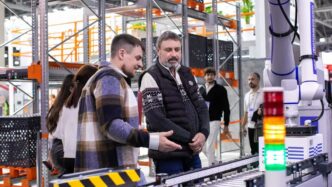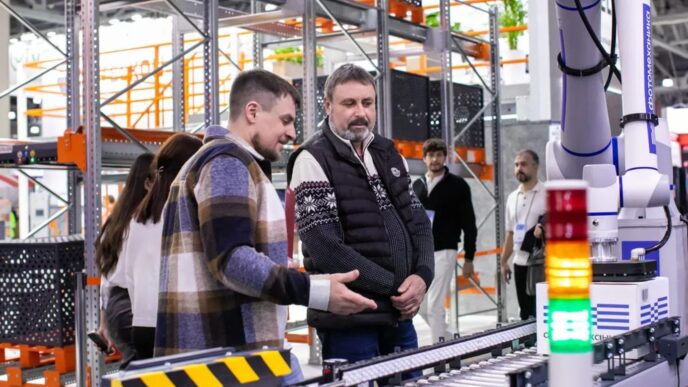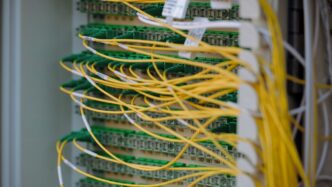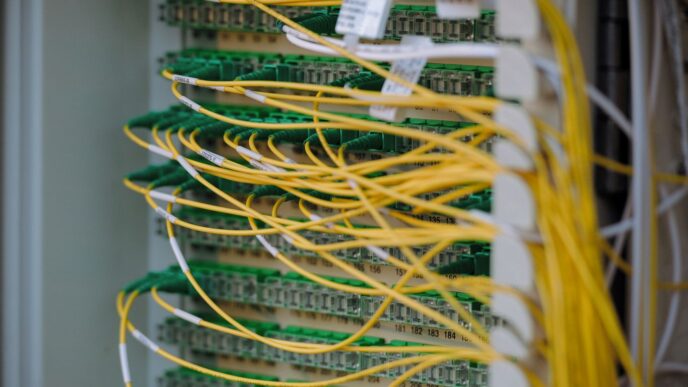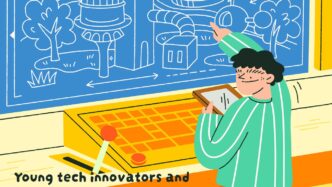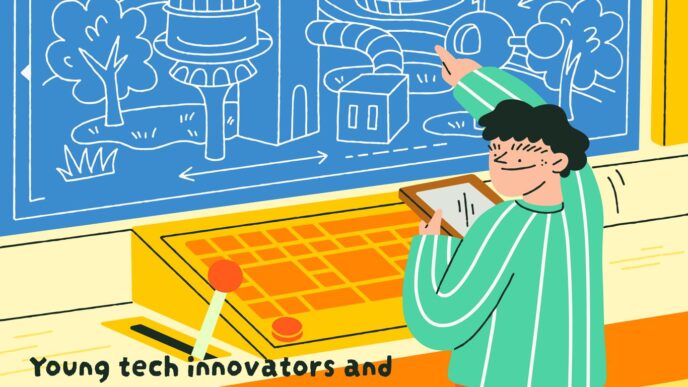Thinking about what life will be like in 2030 can feel a bit like looking into a foggy mirror. We see shapes and hints, but the full picture is still fuzzy. This article takes a look at some of the main ideas floating around about where we might be heading. It’s not about crystal balls, but about understanding the big shifts happening now that could shape our world in just a few years. These 2030 predictions aren’t set in stone, but they give us a direction to think about.
Key Takeaways
- The economy is changing. Instead of just taking resources, we need to focus on rebuilding and restoring things. We’ll need new ways to measure success that go beyond just money, looking at how people and the planet are doing. Technology can help with this, but only if it’s used for good.
- We need to think about the people who will live long after us. This means making decisions today that will benefit future generations, not just ourselves. It involves giving younger people a real say in how things are run.
- Stories matter. Right now, a lot of what we hear is about fear. We need to share more hopeful stories that show people they have power and can work together to make things better. It’s about believing we can be part of the solution.
- The future is uncertain, and that’s okay. We need to get better at imagining different possibilities and being creative when things get complicated. Using a big-picture approach helps us be ready for whatever comes.
- New technologies like AI and gene editing are coming fast. We need to figure out how to use them wisely, making sure they help society without causing new problems. It’s a balancing act between moving forward and being careful.
Shifting Economic Paradigms: Beyond Gross Domestic Product
For decades, we’ve used Gross Domestic Product (GDP) as the main way to measure how well an economy is doing. It’s like checking the score of a game, but it doesn’t tell us much about how healthy the players are or if the game itself is even worth playing. By 2030, we’re going to see a big change in how we think about economic success. It’s not just about making more stuff or having more money; it’s about building an economy that actually helps people and the planet thrive.
Embracing Regeneration Over Extraction
The old way of doing things often involved taking resources from the earth without much thought for the consequences. Think mining, logging, or even just using up natural resources as fast as possible. This approach has led to a lot of environmental problems and social inequalities. The shift by 2030 is towards what we call ‘regeneration.’ This means actively working to restore ecosystems, rebuild communities, and bring back trust. Instead of just extracting, we’ll be focusing on practices that give back more than they take. This could look like farming methods that improve soil health, businesses that invest in local communities, or technologies that help clean up pollution.
New Metrics for Well-being and Progress
If we’re moving beyond GDP, we need new ways to measure success. This isn’t just about tweaking the numbers; it’s about changing what we value. By 2030, expect to see more focus on indicators that reflect genuine human well-being and the health of our planet. These could include:
- Health and Happiness Scores: Measuring how healthy and content people are, not just their income.
- Environmental Quality Indices: Tracking air and water quality, biodiversity, and carbon levels.
- Social Cohesion Metrics: Assessing community strength, trust levels, and access to opportunities.
- Education and Skill Development: Looking at how well people are learning and adapting.
These new metrics will help guide policies and business decisions towards outcomes that truly matter for a good life and a sustainable future.
Incentivizing Public Good Through Technology
Technology, especially things like AI, can play a big role in this economic shift. But it needs to be guided by a purpose that benefits everyone. By 2030, we’ll likely see more efforts to use technology not just for profit, but to support the ‘public good.’ This means using AI to help manage natural resources more efficiently, developing platforms that connect people for community projects, or creating systems that reward companies for positive social and environmental impact. The key will be ensuring that these technologies are governed in ways that prioritize collective benefit over private gain, making sure that innovation serves humanity’s broader goals.
Intergenerational Equity: Voices for Future Generations

It’s easy to talk about ‘future generations’ in a general way, but what does it actually mean to give them a real say in the decisions we’re making right now? We’re talking about thinking way beyond just our own kids or grandkids. Some of the tech we’re developing now, like advanced AI or gene editing, could change things for centuries. That means we need to build systems that look out for people living in, say, 2225, not just those of us alive today.
Embedding Long-Term Stewardship in Policy
Right now, most policies are set up to reward quick wins. It’s like a race where everyone’s focused on crossing the finish line tomorrow, not on what the track will look like next year or the year after. We need to shift that. This means creating rules and structures that encourage looking ahead, making sure that the choices we make today don’t create massive problems for people down the line. It’s about building a sense of responsibility that stretches across time.
Designing Decisions for Centuries Ahead
Think about it: a decision made today about land use, resource management, or even technological development could have ripple effects for hundreds of years. We need to get better at predicting those long-term impacts. This isn’t just about crunching numbers; it’s about using imagination and different ways of thinking to picture what the world might look like and how our current actions will play out.
Youth Engagement in Policy Making
Young people today are inheriting the world we’re shaping. They have a unique perspective on what the future could or should be. Getting them involved in policy discussions isn’t just a nice idea; it’s a necessity. Their energy and fresh viewpoints can challenge the status quo and push us to consider options we might otherwise overlook. We need to actively create pathways for their voices to be heard and genuinely considered, not just as a token gesture, but as a core part of the decision-making process.
Here are a few ways we can make this happen:
- Mentorship Programs: Pair young people with experienced policymakers for direct learning and collaboration.
- Youth Advisory Councils: Establish formal bodies where young representatives can provide input on specific policy areas.
- Future-Focused Education: Integrate long-term thinking and civic responsibility into school curricula from an early age.
The Power of Narrative: Moving Beyond Fear
It feels like everywhere you look these days, there’s a story about doom and gloom. Whether it’s the news, social media, or even just conversations with friends, the air can get thick with worry. We hear about all the problems – climate change, economic worries, social divides – and it’s easy to start feeling pretty helpless, like there’s nothing we can do. This constant stream of negative stories can really wear you down, making it hard to even imagine a better future.
But here’s the thing: stories have a huge impact on how we see the world and what we believe is possible. The narratives we tell ourselves and each other shape our actions, our hopes, and our fears. Right now, a lot of our dominant stories are built on fear – fear of what we might lose, fear of people who are different, and just a general fear of what’s coming next. It’s like we’re stuck in a loop, and it’s tough to break free.
Countering Harmful Stories with Hope
So, what do we do? We can’t just ignore the problems, but we also can’t let fear paralyze us. The first step is to actively push back against those scary, unhelpful stories. This doesn’t mean pretending everything is fine. It means finding and sharing stories that offer a different perspective – stories that show resilience, ingenuity, and connection. Think about the local community garden that’s bringing people together, or the scientists working on clean energy solutions. These aren’t just isolated events; they’re sparks of hope that can grow.
Inviting Agency and Collaboration
Beyond just countering bad news, we need to build new narratives that invite people to be part of the solution. When stories make us feel like passive observers, it’s easy to disengage. But when a story shows us how we can contribute, how our actions matter, and how we can work together, something shifts. It’s about moving from
Navigating Uncertainty: Embracing the Unknown
It feels like the world is always throwing curveballs, right? One minute things seem stable, the next, bam, something completely unexpected happens. Trying to predict every single twist and turn is a losing game. Instead of trying to guess the future, we need to get better at handling whatever comes our way. This means shifting our focus from rigid prediction to building real adaptability. Think of it like learning to surf: you can’t control the waves, but you can learn to ride them. This isn’t about being passive; it’s about being ready.
Developing Public Imagination Capacity
We often get stuck thinking about the future in very narrow ways. We imagine a few likely scenarios, but the reality is usually much more varied. To get better at this, we need to practice imagining different possibilities. This isn’t just for artists or writers; it’s a skill everyone can develop. It’s about training our minds to see multiple paths forward, not just the one that seems most obvious.
- Scenario Thinking: Instead of making one big forecast, we can explore several different
Technological Disruption and Societal Adaptation
It feels like every week there’s some new tech making waves, right? From AI that can write poems to tools that edit genes, things are moving fast. The big question is, how do we, as a society, keep up? We can’t just let these powerful tools run wild without some thought about the consequences. It’s not about stopping progress, but about making sure progress serves us all.
The Role of Artificial Intelligence
AI is already changing how we work, learn, and even entertain ourselves. By 2030, expect it to be even more woven into the fabric of our lives. Think smarter assistants, more personalized education, and maybe even AI helping doctors diagnose illnesses. But there’s a flip side. We need to think about jobs that might change or disappear, and how to make sure AI isn’t used in ways that harm people, like spreading misinformation or making unfair decisions. We need to build AI systems that are fair, transparent, and accountable.
Gene Editing and Geoengineering Impacts
These are the kinds of technologies that sound like science fiction, but they’re becoming real. Gene editing could help us cure diseases, but it also brings up tough questions about
Redefining Progress: A Focus on Human Potential

Forget just chasing numbers on a spreadsheet. By 2030, we’re really starting to rethink what ‘progress’ even means. It’s not just about how much stuff we make or how much money we have. It’s about what actually makes life better for people and the planet. We’re moving away from just taking what we can and starting to think about how we can give back and fix things. This means looking at things differently, not just for us now, but for everyone who comes after us.
Restoring Ecosystems and Cultures
We’ve spent a lot of time, frankly, messing up the environment and some of our traditions. The idea now is to actively fix that. Think of it like cleaning up a big mess, but on a global scale. This isn’t just about planting trees, though that’s part of it. It’s also about bringing back ways of life and community connections that have been lost. We need to get back to a place where nature can thrive and where our cultural heritage is respected and alive.
- Actively re-wilding damaged landscapes.
- Supporting indigenous knowledge for environmental stewardship.
- Investing in community-led cultural preservation projects.
Rebuilding Trust and Social Fabric
It feels like trust has taken a hit lately, doesn’t it? Whether it’s between people, with institutions, or even with information itself. The push by 2030 is to actively mend these broken connections. This involves creating spaces where people can talk openly, understand each other better, and work together on common goals. It’s about strengthening the bonds that hold communities together, making sure everyone feels like they belong and can contribute.
Prioritizing Human Flourishing
So, what’s the end goal of all this? It’s pretty simple, really: human flourishing. This means creating conditions where everyone has the chance to live a good life, to be healthy, to learn, to create, and to feel a sense of purpose. It’s about moving beyond just survival and basic needs to a state where people can truly thrive. This shift in focus from mere economic growth to holistic human well-being is perhaps the most significant redefinition of progress we’ll see.
Here’s a quick look at what that might involve:
| Area of Focus | By 2030 Goal |
|---|---|
| Health & Well-being | Increased access to mental and physical healthcare |
| Education & Learning | Lifelong learning opportunities for all |
| Community & Belonging | Stronger local networks and social support |
| Purpose & Meaning | Greater opportunities for creative expression |
Looking Ahead: Embracing the ‘Beyonds’
So, as we wrap up our look at what the future might hold by 2030, it’s clear things aren’t just going to stay the same. We’ve talked about moving past old ways of measuring success, like just focusing on money, and instead thinking about what truly makes life better for everyone and the planet. It’s also about making sure younger folks have a real say in decisions that will affect them for a long time. We need to get better at telling stories that give us hope and show us we can actually make a difference, instead of just feeling stuck. And with all the new tech popping up, we have to learn to be okay with not knowing everything and be ready to adapt. It’s not about having all the answers, but about being open to new ideas and working together to build a future that’s not just different, but better.
Frequently Asked Questions
What does ‘Beyond GDP’ mean for measuring success?
Instead of just looking at how much money a country makes (GDP), we’re thinking about other important things. This includes how happy and healthy people are, the state of our environment, and if our communities are strong. It’s about valuing things that help everyone and the planet thrive, not just economic growth.
How can we make sure future generations are considered in today’s decisions?
This is about thinking long-term. We need to make choices now that won’t harm people who will live many years from now. It means creating rules and plans that consider the world our great-great-grandchildren will inherit, not just what’s easy for us today.
Why is talking about hope important for the future?
Sometimes, the news and stories we hear are full of worry and fear about what might happen. Focusing on hope helps us believe we can make good things happen. It encourages people to work together and feel like they have the power to create a better future, instead of feeling helpless.
How can we get better at dealing with unexpected changes?
The world changes quickly, and sometimes things happen that we don’t expect. To handle this, we need to be creative and open-minded. Thinking about different possibilities and understanding how different parts of the world connect (like in nature or society) helps us be ready for anything.
What role does technology like AI play in shaping our future?
New technologies like Artificial Intelligence (AI) are changing things fast. They can help us solve big problems, but we also need to be careful. We need to make sure these tools are used in ways that benefit everyone and are managed properly, so they don’t cause harm.
What does it mean to focus on ‘human potential’?
This means we should focus on helping people be their best. It involves taking care of our planet, rebuilding trust between people, and creating societies where everyone can learn, grow, and feel happy and fulfilled. It’s about making sure people, and not just money or things, are the most important focus.





